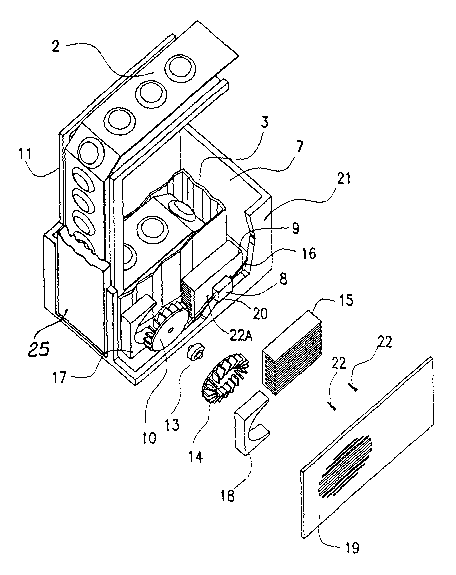Some of the information on this Web page has been provided by external sources. The Government of Canada is not responsible for the accuracy, reliability or currency of the information supplied by external sources. Users wishing to rely upon this information should consult directly with the source of the information. Content provided by external sources is not subject to official languages, privacy and accessibility requirements.
Any discrepancies in the text and image of the Claims and Abstract are due to differing posting times. Text of the Claims and Abstract are posted:
| (12) Patent Application: | (11) CA 2448870 |
|---|---|
| (54) English Title: | COFFEE MACHINE PROVIDED WITH A DEVICE TO COOL THE COFFEE WITH WHICH IT IS LOADED |
| (54) French Title: | MACHINE A CAFE POURVUE D'UN DISPOSITIF PERMETTANT DE REFROIDIR LE CONTENU DE CAFE |
| Status: | Deemed Abandoned and Beyond the Period of Reinstatement - Pending Response to Notice of Disregarded Communication |
| (51) International Patent Classification (IPC): |
|
|---|---|
| (72) Inventors : |
|
| (73) Owners : |
|
| (71) Applicants : |
|
| (74) Agent: | SMART & BIGGAR LP |
| (74) Associate agent: | |
| (45) Issued: | |
| (86) PCT Filing Date: | 2002-05-31 |
| (87) Open to Public Inspection: | 2002-12-19 |
| Availability of licence: | N/A |
| Dedicated to the Public: | N/A |
| (25) Language of filing: | English |
| Patent Cooperation Treaty (PCT): | Yes |
|---|---|
| (86) PCT Filing Number: | PCT/EP2002/005957 |
| (87) International Publication Number: | WO 2002100225 |
| (85) National Entry: | 2003-11-28 |
| (30) Application Priority Data: | ||||||
|---|---|---|---|---|---|---|
|
A Peltier cell (8) is arranged with its cold part adjacent to the loading
compartment of a coffee machine to cool the coffee contained therein;
associated with this cell is a radiant place (15) and a first fan (14) to
dissipate the heat generated by the hot part of the cell and likewise
associated with it there may be a body (9) and a second fan (10) to facilitate
the cooling of the air within the loading compartment.
L'invention concerne une cellule à effet Peltier (8) dont la portion froide est adjacente au compartiment de chargement d'une machine à café afin de refroidir le café contenu dans ledit compartiment. Une plaque rayonnante (15) et un premier ventilateur (14) sont associés à la cellule de manière à dissiper la chaleur générée par la portion chaude de la cellule. En outre, un corps (9) et un second ventilateur (10) peuvent être associés à la cellule afin de faciliter le refroidissement de l'air contenu dans le compartiment de chargement.
Note: Claims are shown in the official language in which they were submitted.
Note: Descriptions are shown in the official language in which they were submitted.

2024-08-01:As part of the Next Generation Patents (NGP) transition, the Canadian Patents Database (CPD) now contains a more detailed Event History, which replicates the Event Log of our new back-office solution.
Please note that "Inactive:" events refers to events no longer in use in our new back-office solution.
For a clearer understanding of the status of the application/patent presented on this page, the site Disclaimer , as well as the definitions for Patent , Event History , Maintenance Fee and Payment History should be consulted.
| Description | Date |
|---|---|
| Application Not Reinstated by Deadline | 2008-06-02 |
| Time Limit for Reversal Expired | 2008-06-02 |
| Inactive: Abandon-RFE+Late fee unpaid-Correspondence sent | 2007-05-31 |
| Deemed Abandoned - Failure to Respond to Maintenance Fee Notice | 2007-05-31 |
| Letter Sent | 2004-04-08 |
| Inactive: Single transfer | 2004-03-01 |
| Amendment Received - Voluntary Amendment | 2004-03-01 |
| Inactive: Cover page published | 2004-02-05 |
| Inactive: Courtesy letter - Evidence | 2004-02-03 |
| Inactive: Notice - National entry - No RFE | 2004-02-03 |
| Application Received - PCT | 2003-12-17 |
| National Entry Requirements Determined Compliant | 2003-11-28 |
| Application Published (Open to Public Inspection) | 2002-12-19 |
| Abandonment Date | Reason | Reinstatement Date |
|---|---|---|
| 2007-05-31 |
The last payment was received on 2006-04-05
Note : If the full payment has not been received on or before the date indicated, a further fee may be required which may be one of the following
Please refer to the CIPO Patent Fees web page to see all current fee amounts.
| Fee Type | Anniversary Year | Due Date | Paid Date |
|---|---|---|---|
| Basic national fee - standard | 2003-11-28 | ||
| Registration of a document | 2004-03-01 | ||
| MF (application, 2nd anniv.) - standard | 02 | 2004-05-31 | 2004-04-23 |
| MF (application, 3rd anniv.) - standard | 03 | 2005-05-31 | 2005-04-20 |
| MF (application, 4th anniv.) - standard | 04 | 2006-05-31 | 2006-04-05 |
Note: Records showing the ownership history in alphabetical order.
| Current Owners on Record |
|---|
| ILLYCAFFE S.P.A. |
| Past Owners on Record |
|---|
| BRUNO DELLAPIETRA |
| FURIO SUGGI LIVERANI |
| ORIANA SAVONITTI |
| ROBERTO CAPPUCCIO |
| STEFANO COSSETTO |